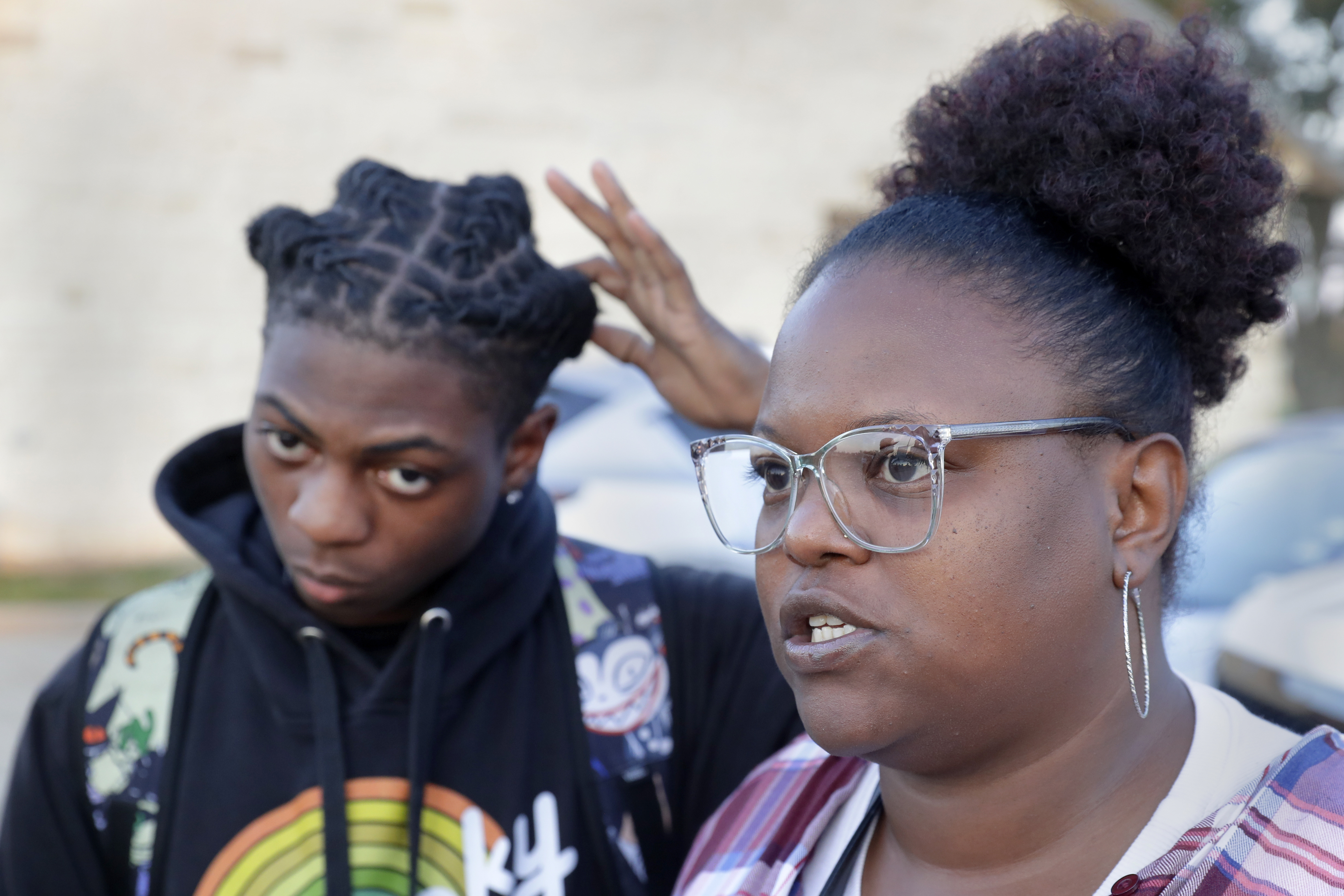
For Greg Poole, the Barbers Hills, Texas, schools superintendent, a court battle over the length of a Black student’s hair comes down to who decides the policies of the Houston-area district. The dispute is ultimately about local control, he wrote in a full-page ad published in the Houston Chronicle.
But for 18-year-old Darryl George and civil rights activists, it is an instance of local authorities imposing discriminatory regulations that conflict with laws meant to prevent race-based hair discrimination.
George is a junior at Barbers Hill High School, who has been suspended from regular classes for most of the school year. He wears locs that he keeps neatly twisted on top of his head, but which the district in Mont Belvieu says violates its dress code because if loose, would be too long. Its code says male students’ hair cannot fall below their eyebrows, earlobes, or the top of a T-shirt collar when let down.
The school district prevailed in a Texas state court on Thursday when a judge ruled in its favor but George has other legal challenges pending.
Get top local stories in DFW delivered to you every morning. Sign up for NBC DFW's News Headlines newsletter.
“Emotionally and academically it has really affected Darryl,” said Candice Matthews, the president of the Texas Coalition of Black Democrats and the family’s spokesperson.
“It’s like he is carrying the weight of our people on his shoulders for this," she said. "He’s not able to participate as a regular teenager, as a regular student, with regular activities.”
School dress and grooming codes have been under scrutiny, particularly amid tensions in schools as some states revise how African American history is taught and curb the rights of transgender students.
In a report released this month, the ACLU found that school districts across Texas applied different rules to males and females, from the length of a student’s hair to who can wear makeup, earrings or sleeveless shirts, while also enforcing rules that discriminate based on race.
The regulations sometimes date to the 1960s when districts wanted males to look clean-cut compared to the Beatles and other rock groups, and now reinforce rigid and outdated gender norms, the report said.
On Thursday, Texas Judge Chap B. Cain III was asked whether the Barbers Hill Independent School District, by demanding that George cut his hair before returning to class, had violated the Texas CROWN Act, passed last year. Cain decided that the school had not.
Cain said the district’s policy, “does not prohibit nor does it discriminate against male students who wear braids, locs, or twists.”
The name is an acronym for Creating a Respectful and Open World for Natural Hair and it prohibits discrimination against a hair texture or protective hairstyle commonly or historically associated with race. There were 24 states with such laws as of July 2023, according to the Economic Policy Institute.
The district had argued that the Texas CROWN Act protects hair texture and the wearing of braids, twists and locs, but makes no mention of length.
“Those with agendas wish to make the CROWN Act a blanket allowance of student expression,” Poole, the superintendent, said in a statement.
Jennesa Calvo-Friedman, a staff lawyer for the American Civil Liberties Union, disagreed.
“I looked in five different dictionaries and in every one, hairstyle’s definition says hairstyle is the way hair is both cut and arranged,” she said. “It includes the word cut. And how a hair is cut includes the length.”
One of the bill’s authors, Democratic Rep. Rhetta Bowers, has said that the bill was intended to cover styles like George’s.
The ACLU report released this month, “Dressed to Express: How Dress Codes Discriminate Against Texas Students and Must Be Changed,” found that more than half of the school districts had dress codes based on gender, including 300 that applied rules about hair length only to males. More than 7% of the state’s districts explicitly prohibited hairstyles and textures associated with race in 2022-2023 dress codes.
“Dress codes sometimes reflect harmful racist, sexist, and anti-LGBTQIA+ stereotypes; infringe on students’ religious liberties; and discriminate based on disability or socioeconomic status,” the report said.
Even dress codes written in neutral language can be applied unevenly, targeting students of color, LGBTQIA+ students, students with disabilities and students from diverse backgrounds, it said.
The survey offers examples of Black students being pressured to cut their hair. A male student in the Greenwood Independent School District was told in 2018 that he would no longer be allowed to play football if he did not cut his cornrows, it said. In 2021, an 11-year-old student in the Troy Independent School District was sent to in-school suspension for more than 10 days because a top knot that he wore to honor his African heritage violated the school’s dress code, it said.
An earlier report from the Government Accountability Office, in October 2022, looked at dress codes across the country. It found that most had rules about hair, hairstyles and head coverings that can disproportionately affect Black students and others of certain religions and cultures.
A higher percentage of schools in the South enforce strict dress codes, including 71% in Texas, Oklahoma, Louisiana and Arkansas, compared to only 28% in New England, it found. Schools that enforce strict codes are predominantly Black and Hispanic and are more likely to remove students from class.
“While school districts often cite safety as the reason for having a dress code, many dress codes include elements that may make the school environment less equitable and safe for students,” the report said in its highlights.
George — who has been assigned to in-school suspension or a disciplinary program since the end of August and who was denied a religious exemption — has filed a federal civil rights lawsuit against the school district, Texas Gov. Greg Abbott and Attorney General Ken Paxton, and a complaint with the Texas Education Agency.
George “has worn his natural hair in locs as an outward expression of his Black identity and culture for several years now,” Allie Booker, the family’s attorney, wrote in the federal lawsuit. “He has the hair of his stepfather, his father, and other family members tied and sewn off into his locs as is indicative of his culture.”
The school district’s “so-called neutral grooming policy has no close association with learning or safety and when applied, disproportionately impacts Black males,” she wrote.
Poole has compared the district’s policy to those of the country’s military academies.
“Our military academies in West Point, Annapolis and Colorado Springs maintain a rigorous expectation of dress,” he wrote in the Houston Chronicle ad. “They realize being an American requires conformity with the positive benefit of unity, and being a part of something bigger than yourself.”
The Barbers Hill school district’s earlier suspension of two students over their hair, Everett De’Andre Arnold and Kaden Bradford, sparked the passing of the CROWN Act. After a federal lawsuit was filed in 2020 alleging race and sex discrimination and a violation of their rights to free speech, a judge found that the claims were likely to succeed and prevented the district from enforcing the policy against them. That lawsuit continues.
Elsewhere, school districts have tried to force Native American students to cut their hair, in Girard, Kansas, and Leland, North Carolina, Calvo-Friedman said. The Kansas school district changed its policy after the ACLU sent a letter to the school board, while the North Carolina charter school, Classical Charter Schools of America, is not enforcing its policy, she said. Several boys have changed schools though because it remains in effect.
“Short hair codes for boys reflect and reinforce harmful stereotypes that are based on race and sex and it tells students that the only appropriate way to look like a boy is to have short hair,” Calvo-Friedman said. “And that’s not true now and nor has it ever been true, particularly for men of color.”
Tehia Starker Glass, an education professor at the University of North Carolina in Charlotte and co-author of Teaching for Justice & Belonging said that young people are more willing to challenge outdated policies.
Their activism follows the Black Lives Matter protests spurred by the killing of George Floyd by a police officer in Minneapolis in 2020. Pushback historically follows progress, she said, and policies are becoming more restrictive as young people continue to focus on injustice.
“Our young people are a lot more skilled in advocating for themselves so they are okay in letting folks know that something is not right or it’s not fair,” she said.



